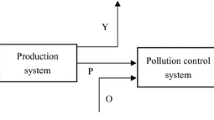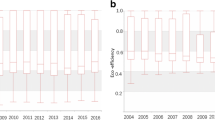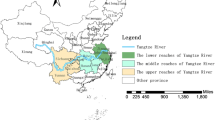Abstract
In this study, an improved matrix-type network data envelopment analysis (NDEA) model with undesirable output was developed to evaluate the eco-efficiency of China’s 30 provinces. The proposed model considered three linked but independent subsystems of the economy–society–environment cyclic system. Additionally, to allocate the weights of the NDEA model among the three subsystems (environment, economy, and society) of the eco-environment, a new relative reduction of the input-based method was proposed. The results show that, from 2003 to 2016, the average eco-efficiency of China’s 30 provinces was low, ranging in [0.59, 0.73]. Qinghai and Hainan ranked first and second, respectively, in average eco-efficiencies, while both Shaanxi and Xinjiang had the lowest average eco-efficiencies. Affected by the low social subsystem efficiency, the eco-efficiency of 18 provinces decreased, but the range of the decrease was smaller than that of the increase in 11 other provinces in which the eco-efficiency improved. The average efficiency of the environmental subsystem is the highest among the three subsystems benefiting from reducing the emissions of “three industrial wastes,” while economic subsystem owns the lowest average efficiency due to the input redundancy of total fixed assets and energy consumption. Compared with variables’ projection, for most provinces, the undesirable output of the three industrial wastes should be reduced by more than 88.0%, while the positive outputs of atmospheric quality and per capita years of education should be increased by at least 61.0%.





Similar content being viewed by others
Notes
http://www.gov.cn/premier/2019-03/16/content_5374314.htm
References
Azad MAS, Ancev T (2014) Measuring environmental efficiency of agricultural water use: a Luenberger environmental indicator. J Environ Manag 145:314–320
Bai Y, Deng X, Jiang S, Zhang Q, Wang Z (2018) Exploring the relationship between urbanization and urban eco-efficiency: evidence from prefecture-level cities in China. J Clean Prod 195:1487–1496
Banker RD, Charnes A, Cooper WW (1984) Some models for estimating technical and scale inefficiencies in data envelopment analysis. Manag Sci 30:1078–1092
Beltrán-Esteve M, Reig-Martínez E, Estruch-Guitart V (2017) Assessing eco-efficiency: a metafrontier directional distance function approach using life cycle analysis. Environ Impact Assess Rev 63:116–127
Bian Y, Yang F (2010) Resource and environment efficiency analysis of provinces in China: a DEA approach based on Shannon’s entropy. Energy Policy 38:1909–1917
Bing Z, Bi J, Fan Z, Yuan Z, Ge J (2008) Eco-efficiency analysis of industrial system in China: a data envelopment analysis approach. Ecol Econ 68:306–316
Bogetoft P (1996) DEA on relaxed convexity assumptions. Manag Sci 42:457–465
Charnes A, Cooper WW, Rhodes E (1979) Measuring the efficiency of decision making units. Eur J Oper Res 2:429–444
Chen P-C, Chang C-C, Yu M-M, Hsu S-H (2012) Performance measurement for incineration plants using multi-activity network data envelopment analysis: the case of Taiwan. J Environ Manag 93:95–103
Chen J, Song M, Long X (2015) Evaluation of environmental efficiency in China using data envelopment analysis. Ecol Indic 52:577–583
Chen N, Xu L, Chen Z (2017) Environmental efficiency analysis of the Yangtze River economic zone using super efficiency data envelopment analysis (SEDEA) and tobit models. Energy 134:659–671
Cheng Y, Yang YS, Guo CQ (2012) Network data envelopment analysis efficiency measure to matrix-type organization with an application in input-output tables. Afr J Bus Manag 6:6997–7004
Cooper WW, Seiford LM, Tone K (2001) Data envelopment analysis: a comprehensive text with models, applications, references and DEA-solver software.Interfaces 31: 116-118
CSC (2010) Several opinions on promoting the construction and development of Hainan international tourism island
Fan Y, Bai B, Qiao Q, Kang P, Zhang Y, Guo J (2017) Study on eco-efficiency of industrial parks in China based on data envelopment analysis. J Environ Manag 192:107–115
Färe R (1991) Measuring Farrell efficiency for a firm with intermediate inputs. Acad Econ Pap 19:329–340
Färe R, Grosskopf S (2000) Network DEA. Socio Econ Plan Sci 34:35–49
Farrell MJ (1957) The measurement of productive efficiency. J R Stat Soc A 120:253–281
Gómez T, Gémar G, Molinos-Senante M, Sala-Garrido R, Caballero R (2018) Measuring the eco-efficiency of wastewater treatment plants under data uncertainty. J Environ Manag 226:484–492
Hailu A, Veeman TS (2001) Non-parametric productivity analysis with undesirable outputs: an application to the Canadian pulp and paper industry. Am J Agric Econ 83:605–616
Halkos GE, Polemis ML (2018) The impact of economic growth on environmental efficiency of the electricity sector: a hybrid window DEA methodology for the USA. J Environ Manag 211:334–346
Han Y, Long C, Geng Z, Zhang K (2018) Carbon emission analysis and evaluation of industrial departments in China: an improved environmental DEA cross model based on information entropy. J Environ Manag 205:298–307
Hatami-Marbini A, Saati S (2018) Efficiency evaluation in two-stage data envelopment analysis under a fuzzy environment: a common-weights approach. Appl Soft Comput 72:156–165
He F, Zhang Q, Lei J, Fu W, Xu X (2013) Energy efficiency and productivity change of China’s iron and steel industry: accounting for undesirable outputs. Energy Policy 54:204–213
Hernández-Chover V, Bellver-Domingo Á, Hernández-Sancho F (2018) Efficiency of wastewater treatment facilities: the influence of scale economies. J Environ Manag 228:77–84
Huang D, Xu J, Zhang S (2012) Valuing the health risks of particulate air pollution in the Pearl River Delta, China. Environ Sci Pol 15:38–47
Huang J, Xia J, Yu Y, Zhang N (2018) Composite eco-efficiency indicators for China based on data envelopment analysis. Ecol Indic 85:674–697
Kao C, Hwang S-N (2008) Efficiency decomposition in two-stage data envelopment analysis: an application to non-life insurance companies in Taiwan. Eur J Oper Res 185:418–429
Korhonen PJ, Luptacik M (2004) Eco-efficiency analysis of power plants: an extension of data envelopment analysis. Eur J Oper Res 154:437–446
Kuosmanen T (2005) Measurement and analysis of eco-efficiency: an economist’s perspective. J Ind Ecol 9:15–18
Lewis HF, Sexton TR (2004) Network DEA: efficiency analysis of organizations with complex internal structure. Comput Oper Res 31:1365–1410
Li M, Wang Q (2014) International environmental efficiency differences and their determinants. Energy 78:411–420
Li Z, Ouyang X, Du K, Zhao Y (2017) Does government transparency contribute to improved eco-efficiency performance? An empirical study of 262 cities in China. Energy Policy 110:79–89
Liang C, Jia G (2017) Environmental efficiency analysis of China’s regional industry: a data envelopment analysis (DEA) based approach. J Clean Prod 142:846–853
Liang L, Wu J, Cook WD, Zhu J (2008) Alternative secondary goals in DEA cross-efficiency evaluation. Int J Prod Econ 113:1025–1030
Lim S, Zhu J (2019) Primal-dual correspondence and frontier projections in two-stage network DEA models. Omega 83:236–248
Lin T-Y (2018) Two-stage performance evaluation of domestic and foreign banks in Taiwan. Asian J Econ Model 6:191–202
Lin B, Zhu J (2019) Impact of energy saving and emission reduction policy on urban sustainable development: empirical evidence from China. Appl Energy 239:12–22
Lin YY, Chen PY, Chen CC (2013) Measuring the environmental efficiency of countries: a directional distance function metafrontier approach. J Environ Manag 119:134–142
List JA, Gallet CA (1999) The environmental Kuznets curve: does one size fit all? Ecol Econ 31:409–423
Liu X, Zhou D, Zhou P, Wang Q (2017) Dynamic carbon emission performance of Chinese airlines: a global Malmquist index analysis. J Air Transp Manag 65:99–109
Maghbouli M, Amirteimoori A, Kordrostami S (2014) Two-stage network structures with undesirable outputs: a DEA based approach. Measurement 48:109–118
Mehmeti A, Todorovic M, Scardigno A (2016) Assessing the eco-efficiency improvements of Sinistra Ofanto irrigation scheme. J Clean Prod 138:208–216
Meng F, Su B, Thomson E, Zhou D, Zhou P (2016) Measuring China’s regional energy and carbon emission efficiency with DEA models: a survey. Appl Energy 183:1–21
NEPD. Technical guidelines for the delimitation of ecological protection red line 2015
OECD. The economic consequences of outdoor air pollution. OECD Publishing Paris 2016
Paatero P, Tapper U (1994) Positive matrix factorization: a non-negative factor model with optimal utilization of error estimates of data values. Environmetrics 5:111–126
Reap J, Roman F, Duncan S, Bras B (2008) A survey of unresolved problems in life cycle assessment. Int J Life Cycle Assess 13:374
Ren S, Li X, Yuan B, Li D, Chen X (2018) The effects of three types of environmental regulation on eco-efficiency: a cross-region analysis in China. J Clean Prod 173:245–255
Sarkis J (2000) Ecoefficiency: how data envelopment analysis can be used by managers and researchers. Proceedings of Environmentally Conscious Manufacturing:194–203. Boston, MA, United States.
Schaltegger S, Sturm A (1990) Ecological rationality: approaches to design of ecology-oriented management instruments. Die Unternehmung 4:273–290
Song M, Wang J (2018) Environmental efficiency evaluation of thermal power generation in China based on a slack-based endogenous directional distance function model. Energy 161:325–336
Song M, Song Y, An Q, Yu H (2013) Review of environmental efficiency and its influencing factors in China: 1998-2009. Renew Sust Energ Rev 20:8–14
Song M, Peng J, Wang J, Zhao J (2018) Environmental efficiency and economic growth of China: a ray slack-based model analysis. Eur J Oper Res 269:51–63
Song M, Wang S, Lei L, Zhou L (2019) Environmental efficiency and policy change in China: a new meta-frontier non-radial angle efficiency evaluation approach. Process Saf Environ Prot 121:281–289
Tone K (2004) Dealing with undesirable outputs in DEA: a slacks-based measure (SBM) approach. Oper Res Soc Jpn 1:44-45.
Tone K, Tsutsui M (2009) Network DEA: a slacks-based measure approach. Eur J Oper Res 197:243–252
Tone K, Tsutsui M (2014) Dynamic DEA with network structure: a slacks-based measure approach. Omega 42:124–131
Tsutsui M, Goto M (2009) A multi-division efficiency evaluation of US electric power companies using a weighted slacks-based measure. Socio Econ Plan Sci 43:201–208
Ueda T, Amatatsu H (2010) Proposition of new network DEA models based on the unified DEA model. The Ninth International Symposium on Operations Research and Its Applications (ISORA’10) 470–482
Wang Y-M, Chin K-S (2010) Some alternative models for DEA cross-efficiency evaluation. Int J Prod Econ 128:332–338
Wang K, Lu B, Wei YM (2013a) China’s regional energy and environmental efficiency: a range-adjusted measure based analysis. Appl Energy 112:1403–1415
Wang K, Yu S, Zhang W (2013b) China’s regional energy and environmental efficiency: a DEA window analysis based dynamic evaluation. Math Comput Model 58:1117–1127
Wang K, Zhang J, Wei Y-M (2017) Operational and environmental performance in China’s thermal power industry: taking an effectiveness measure as complement to an efficiency measure. J Environ Manag 192:254–270
Wang K, Wei YM, Huang Z (2018a) Environmental efficiency and abatement efficiency measurements of China’s thermal power industry: a data envelopment analysis based materials balance approach. Eur J Oper Res 269:35–50
Wang Q, Hang Y, Hu JL, Chiu CR (2018b) An alternative metafrontier framework for measuring the heterogeneity of technology. Nav Res Logist 65:427–445
Woo C, Chung Y, Chun D, Seo H, Hong S (2015) The static and dynamic environmental efficiency of renewable energy: a Malmquist index analysis of OECD countries. Renew Sustain Energy Rev 47:367–376
Wu J, Wu Z, Hollaender R (2012) The application of positive matrix factorization (PMF) to eco-efficiency analysis. J Environ Manag 98:11–14
Wu J, Yin P, Sun J, Chu J, Liang L (2016) Evaluating the environmental efficiency of a two-stage system with undesired outputs by a DEA approach: an interest preference perspective. Eur J Oper Res 254:1047–1062
Wu Y, Ke Y, Xu C, Xiao X, Hu Y (2018) Eco-efficiency measurement of coal-fired power plants in China using super efficiency data envelopment analysis. Sustain Cities Soc 36:157–168
Xia Y, Li Y, Guan D, Tinoco DM, Xia J, Yan Z, Yang J, Liu Q, Huo H (2018) Assessment of the economic impacts of heat waves: a case study of Nanjing, China. J Clean Prod 171:811–819
Yagi M, Fujii H, Hoang V, Managi S (2015) Environmental efficiency of energy, materials, and emissions. J Environ Manag 161:206–218
Yale. 2018 Environmental performance index. Yale Center for Environmental Law & Policy, Yale University 2018
Yang H, Pollitt M (2009) Incorporating both undesirable outputs and uncontrollable variables into DEA: the performance of Chinese coal-fired power plants. Eur J Oper Res 197:1095–1105
Yang L, Wang KL (2013) Regional differences of environmental efficiency of China’s energy utilization and environmental regulation cost based on provincial panel data and DEA method. Math Comput Model 58:1074–1083
Yang L, Yang Y (2019) Evaluation of eco-efficiency in China from 1978 to 2016: based on a modified ecological footprint model. Sci Total Environ 662:581–590
Yu S, Zheng S, Li X, Li L (2018) China can peak its energy-related carbon emissions before 2025: evidence from industry restructuring. Energy Econ 73:91–107
Yu Y, Chong P, Li Y (2019) Do neighboring prefectures matter in promoting eco-efficiency? Empirical evidence from China. Technol Forecast Soc Chang 144:456–465
Yue H, Lin L, Yantuan Y (2018a) Do urban agglomerations outperform non-agglomerations? A new perspective on exploring the eco-efficiency of Yangtze River Economic Belt in China. J Clean Prod 202:1056–1067
Yue H, Lin L, Yu Y (2018b) Does urban cluster promote the increase of urban eco-efficiency? Evidence from Chinese cities. J Clean Prod 197:957–971
Zhou C, Shi C, Wang S, Zhang G (2018) Estimation of eco-efficiency and its influencing factors in Guangdong province based on super-SBM and panel regression models. Ecol Indic 86:67–80
Funding
The study is financially supported by the National Natural Science Foundation of China (grant nos.71822403,71573236 and 31961143006 ) and Hubei Natural Science Foundation (grant no. 2019CFA089).
Author information
Authors and Affiliations
Corresponding author
Additional information
Responsible editor: Eyup Dogan
Publisher’s note
Springer Nature remains neutral with regard to jurisdictional claims in published maps and institutional affiliations.
Appendix
Appendix
Rights and permissions
About this article
Cite this article
Yu, S., Liu, J. & Li, L. Evaluating provincial eco-efficiency in China: an improved network data envelopment analysis model with undesirable output. Environ Sci Pollut Res 27, 6886–6903 (2020). https://doi.org/10.1007/s11356-019-06958-2
Received:
Accepted:
Published:
Issue Date:
DOI: https://doi.org/10.1007/s11356-019-06958-2




